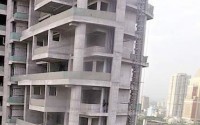Builders go for cheap technology for low cost housing projects
Developers and builders are rushing out to acquire cheap land and technology for low-cost housing after the government announced incentives for affordable housing. The government and central bank also announced cheaper loans to developers and buyers.
Prominent real estate companies including Tata Housing, ATS Infrastructure, Bhartiya Group and Anantraj Industries are busy sewing up land deals for projects in the Rs 5-20 lakh home segment. According to experts, there is unlimited demand for homes in this segment. “There is a large market for such homes but a big supply constraint as well,” said Shailesh Pathak, executive director of the Bhartiya Group, which is planning to build 10,000 low-cost homes over the next two-three years on a 50-acre land near Chennai. Its larger plan is to upscale this to a million homes in the next decade across the country.
As per the statistics put out by the ministry of housing, India faces a shortage of 18.78 million homes, of which 96% is in the economically weaker and low-income segments. The challenge for builders is to find cheaper land that makes it economically viable for them to build such homes. Such lands, however, are only available away from the cities, where, in most cases, there is a lack of transport facilities.
The builders can keep cost of construction under control by adopting technology to speed up construction. Tata Housing, which has decided on a long-term strategy for this segment, has set up a pre-cast plant in Bangalore where a house is literally manufactured and then assembled on site.
“This technology standardises our homes and because it is factory based, we save on both time and cost,” said Rajeeb Kumar Dash, head of marketing services at Tata Housing. What conventional construction achieves in three to four years, this technology does in two to three years. The one year saved translates into cost benefits. Korea has been successful in providing mass housing, while Mexico and South Africa have interesting success stories, says Pathak of the Bhartiya Group.
His company is looking at international and other Indian case studies with the aim of incorporating key learnings and eventually adopting one of the technologies. Noida-based ATS Infrastructure has built 400 apartments priced less than Rs. 10 lakh in Bulandshahr in Uttar Pradesh and is looking at similar projects on the outskirts of tier-2 cities such as Muradabad, Kanpur, Saharanpur and Bhiwadi.
Mayank Saksena, Managing Director at property advisory firm JLL, said several developers are looking at buying cheap land and some are even open to revenue share and joint developments for projects with owners of land in good locations. But there is a word of caution. While the government has articulated a clear vision for housing in the budget this month, apart from cheaper capital and land, approval delays and regulatory hurdles need to be sorted out. “Any delays could severely impact such projects because of the thin margins they operate on,” said Vishal Gupta, managing director of Ashiana Housing.
In an interview to a newspaper, managing director of ATS infrastructure G. Anand said, “This is a volume game, with very thin margins.” Builders are working on different models. Anantraj Industries, for instance, secured cheap land from the Rajasthan government in Neemrana, but on condition that the company would not sell houses over a certain price. It built 2,300 homes with one room, toilet and kitchen in the industrial area and sold them at Rs 8-9 lakh each. “We are now looking at replicating the model for other projects as well. Low cost of land and low cost of money will help,” said Amit Sarin, director at Anant Raj Industries. ATS Infrastructure would look at incurring capital expenditure for technology only after a certain scale is reached. At the moment, his in-house construction team sources materials from around project sites to keep costs low, as did noted British-born Indian architect Laurie Bake.



